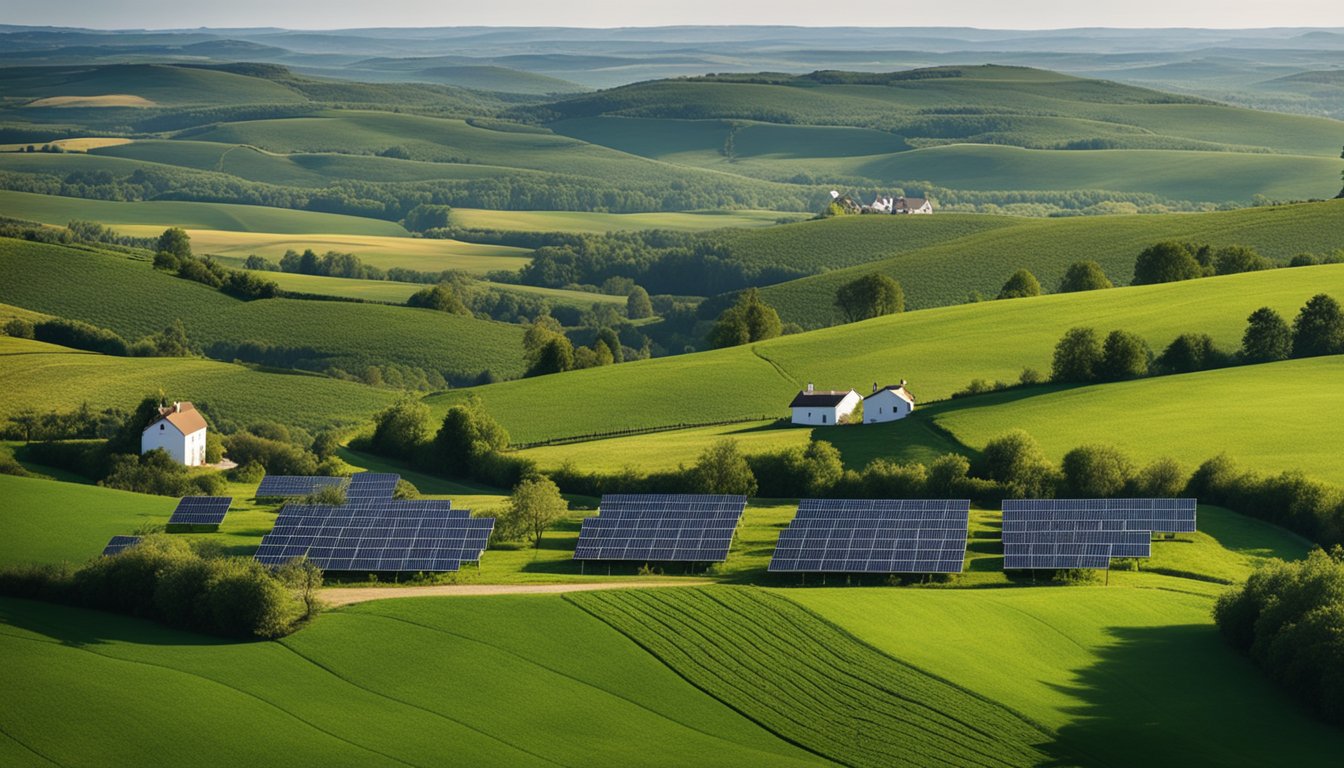Late updated: 15 Nov 2024 13:11
Written by: Oliver Bennett
Sustainable Internet Solutions For UK Countryside: Enhancing Connectivity and Eco-Friendliness
In the sprawling landscapes of the UK countryside, the issue of reliable internet connectivity remains a pressing concern. As we witness a surge in digital innovation, the digital divide between urban and rural communities becomes more pronounced. Sustainable internet solutions are crucial for ensuring that rural areas can benefit from robust digital infrastructure, breaking barriers to connectivity and fostering community growth.

There's a vibrant blend of traditional and cutting-edge technologies that aim to bridge this divide. From leveraging government initiatives to deploy fibre networks to exploring satellite broadband as a viable alternative, multiple avenues are being tested. Our exploration of these options aims to maximise the impact of these internet solutions, enhancing the lives of those in remote locations.
Our conversation around sustainable internet solutions is not just about technology—it's about transforming lives. Engage with us as we delve into the various factors that define and influence digital infrastructure development in rural UK, ensuring that no community is left behind in this digital age.
Key Takeaways
- Sustainable internet closes the digital divide in rural areas.
- Satellite and fibre broadband are key solutions.
- Government initiatives support digital infrastructure.
Developing Digital Infrastructure in the Countryside

Our journey toward sustainable internet solutions in the UK countryside involves several crucial steps. We must assess current connectivity, explore relevant broadband technologies, and examine both government and private sector initiatives. Understanding these elements is key to overcoming digital challenges in rural areas.
Assessing the Current State of Connectivity
Rural broadband across the UK varies significantly. While some areas enjoy high-speed gigabit-capable broadband, others, especially in remote areas like parts of Yorkshire and Cornwall, face persistent challenges. This digital divide is particularly evident in rural premises where internet infrastructure lags behind the urban standard.
Partial progress is visible in areas benefiting from full fibre installations. Yet, substantial gaps remain, requiring further investment and targeted efforts to bring these underserved locations up to speed. We must address these disparities to improve quality of life and foster economic development in the countryside.
Broadband Technologies for Rural Areas
Choosing the right technology is crucial for expanding broadband coverage in rural regions. Full fibre broadband offers fast, reliable connections suitable for long-term solutions. Gigabit-capable options can meet growing data demands, thus supporting both business and residential users.
For extremely remote homes and challenging terrains, satellite broadband provides an alternative. This technology, while dependent on data limits and weather conditions, can serve isolated communities better than traditional methods. Balancing these technologies allows us to tailor solutions to specific geographic and demographic needs.
Government Initiatives and Funding Schemes
Government initiatives like Project Gigabit and the Shared Rural Network play a pivotal role in enhancing digital infrastructure. These schemes aim to deliver gigabit connections across the countryside by investing billions into rural network improvements. Such support is complemented by programmes like the Broadband Voucher Scheme and its gigabit variant, which empower communities to fund local projects.
Comprehensive plans also discuss enforcing the Universal Service Obligation to ensure all households achieve a basic level of broadband coverage. The combined efforts through these policies underscore the commitment to bridging the digital gap.
Private Sector Involvement and Projects
Private sector engagement is crucial in developing broadband infrastructure. Companies specialising in telecommunications and technology deployment lead various projects aimed at improving connectivity in rural areas. Partnerships with community-based initiatives, such as those in Cumbria, foster innovation and cost-effective solutions.
Telecom providers frequently collaborate with government schemes to roll out full fibre broadband, ensuring wider access and reliability. Investment from private entities often complements public funding, highlighting a collaborative approach to solving rural connectivity challenges. Leveraging strengths from both sectors is essential for achieving seamless internet access across the UK countryside.
Maximising the Impact of Internet Solutions

Rural internet solutions can transform access to education, employment, and social inclusion. These connections not only bridge digital divides within underserved areas but also empower small businesses and community enterprises.
Enhancing Education and Employment Opportunities
High-speed broadband can open new education avenues for students in rural homes by providing access to online courses and resources. For those in hard-to-reach premises, services like Starlink and Fibrus offer gigabit-capable connections, removing the digital slow lane barrier.
Employment prospects also rise as remote work becomes feasible. Rural residents can pursue careers that were previously limited to urban areas. Developing robust digital connectivity ensures learners and job seekers across the countryside aren't left behind.
Empowering Small Businesses and Rural Enterprises
Fast and reliable internet enables small businesses in Somerset and Herefordshire to compete more effectively. With enhanced digital connectivity, they can reach broader markets, benefit from e-commerce, and utilise cloud-based services.
Local enterprises, reinforced by improved connection methods from providers like Openreach, can lower operational costs and expand service offerings. Supporting these businesses bolsters rural economies, providing more jobs and stabilising communities.
Improving Social Benefits and Digital Inclusion
Digital inclusion is crucial for the social well-being of residents in very hard-to-reach areas. Reliable internet supports access to essential services, healthcare, and community activities, enhancing overall life quality.
Broadband expansion reduces social isolation and fosters community engagement. Improved residential premises connectivity empowers individuals to harness technology for daily tasks, promoting inclusivity and participation.
By consciously investing in 4G mobile coverage and reducing connection charges, we can make a significant difference in the lives of rural populations.
Frequently Asked Questions

Ensuring effective internet solutions in rural UK areas involves various approaches and technological advancements. We explore different providers and innovative options to enhance connectivity. We'll also discuss the challenges and best practices for setting up sustainable internet solutions.
What are the most effective approaches to securing internet access in rural UK areas?
Rural areas face unique challenges in internet connectivity due to their remote locations. Among the most effective solutions are satellite broadband, which bypasses traditional infrastructure, and mobile broadband options like 4G and 5G, offering flexibility and faster speeds.
Which providers offer the highest quality rural internet service in the UK?
Several providers focus on rural broadband. BT, Sky, and Virgin Media are prominent names, although smaller firms like Gigaclear and Hyperoptic specifically cater to rural demands, offering tailored packages that can sometimes offer faster speeds than larger providers.
What are the innovative options for enhancing WIFI connectivity in remote UK locations?
Innovative solutions such as mesh WiFi networks can significantly boost connectivity by improving coverage across vast rural properties. Additionally, experimenting with line-of-sight fixed wireless solutions or community-driven networks can extend services to households beyond the reach of traditional providers.
What challenges are faced in delivering high-speed internet to the UK countryside?
Rural regions often encounter challenges like geographical barriers and high infrastructure costs. Maintaining consistent speed over long distances and overcoming local regulatory hurdles also complicate efforts to provide high-speed internet in these areas.
Can you detail the best practices for setting up sustainable internet in UK rural settings?
Best practices include conducting a thorough site assessment and selecting a scalable technology solution. Engaging with local community initiatives and leveraging government vouchers or schemes can offset installation costs. Regular maintenance and updates ensure the long-term sustainability of services.
What technological advancements are aiding the improvement of internet services in the UK's rural regions?
Emerging technologies such as low Earth orbit (LEO) satellites, coupled with advancements in 5G technology, provide promising solutions for rural areas. These innovations offer the potential for higher bandwidth and reduced latency, helping bridge the connectivity gap in remote regions.
